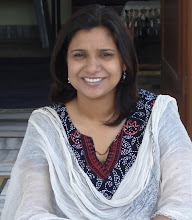I read somewhere that humans at best utilize only 33% of their brains in their lifetime and for someone like me it would be around 0.33%. However, today was an exception with nothing better to do I picked up ' Banker to the Poor' from the library and could not put the book down till I had but finsihed reading it.
I have read several accounts of how this autobiography of Prof.Md. Yunus has inspired people to join the MF sector, but frankly could never understand the impact a single book can make on deciding people's career choices. But now I can say that I fully understand what those people meant.
The book has further reinforced my faith in microfinance. Some things that would stay with me for a long time are:
1. Start Slowly: get to know the community first, work with people win their trust spend time and your microfinnace initaive will be a success.
2. Engagement with the govt: It is important to work with and engage govt institutions (however frustating the task)
3. Never loose focus of your target group:MF services should be aimed at poorest of the poor. Poor itself is a very vague term
4. Remember Gresham's law: the poor and the rich cannot be part of the same inytervention/programme. The rich invariably would benefit at the expense of the poor
5. Providing micro finance is not a end in itself, it is a tool to acheive an end which being povert eradication
A poverty free world is possible...........
Saturday, May 31, 2008
Thursday, May 29, 2008
Rajasthan Microfinance Sector Report 2007

The Rajasthan microFinance Report 2007 was released on 10th January 2008 at the Annual microFinance Colloquium organized by Centre for microFinance, Jaipur. The report a first of its kind for a state, will act as a bench mark for the sector. It presents a comprehensive picture of the current status of microFinance in Rajasthan.
As local context guides the development of the sector, the report is grounded in the realities of Rajasthan. It is the largest state in India and occupies 10 percent of the total area of the country. The state has a population of 56.67 million, which is about 5.5 percent of the country’s population. Around 17.29 Lakh rural households are Below Poverty Line. Through the SHG around 24 lakh people,( mostly women ) have been provided mF services.
It analyses the demand for microfinance services amongst poor, who is serving these needs, what is the potential for growth and the constraints faced by mF service providers in the state. It attempts to map the unreached sections and areas in the state where microFinance services are yet to make in roads.
It highlights the fact that inspite of the advantages of microFinance, the outreach of the sector in the state is insufficient, geographically limited and not organized. While the cumulative disbursement under SHG programme is around 362 crore (as on March 2007), the outstanding credit through SHGs is around Rs170 crore, a miniscule figure given the annual demand. Moreover, 50 percent of the SHGs are concentrated in nine districts only out of the thirty two districts. There are only a couple of MFIs operating in the state, with work areas limited to three to four districts.
In Rajasthan serious efforts are being made to deliver mF services to a large number of households. This report documents these efforts, shows the weaknesses and indicates the opportunities.
It will help mF stakeholders at various levels in preparing an appropriate strategy for growth and expansion of the sector. Researchers will get an idea of the current systems of knowledge creation and inherent gaps
Limited number of print copies (along with CD) is available with Centre for microFinance, Jaipur. The report is priced at a token amount of Rs 180/-(including postal charges). To order your copy of the ‘Rajasthan microFinance Report 2007’please contact payal@cmfraj.org
As local context guides the development of the sector, the report is grounded in the realities of Rajasthan. It is the largest state in India and occupies 10 percent of the total area of the country. The state has a population of 56.67 million, which is about 5.5 percent of the country’s population. Around 17.29 Lakh rural households are Below Poverty Line. Through the SHG around 24 lakh people,( mostly women ) have been provided mF services.
It analyses the demand for microfinance services amongst poor, who is serving these needs, what is the potential for growth and the constraints faced by mF service providers in the state. It attempts to map the unreached sections and areas in the state where microFinance services are yet to make in roads.
It highlights the fact that inspite of the advantages of microFinance, the outreach of the sector in the state is insufficient, geographically limited and not organized. While the cumulative disbursement under SHG programme is around 362 crore (as on March 2007), the outstanding credit through SHGs is around Rs170 crore, a miniscule figure given the annual demand. Moreover, 50 percent of the SHGs are concentrated in nine districts only out of the thirty two districts. There are only a couple of MFIs operating in the state, with work areas limited to three to four districts.
In Rajasthan serious efforts are being made to deliver mF services to a large number of households. This report documents these efforts, shows the weaknesses and indicates the opportunities.
It will help mF stakeholders at various levels in preparing an appropriate strategy for growth and expansion of the sector. Researchers will get an idea of the current systems of knowledge creation and inherent gaps
Limited number of print copies (along with CD) is available with Centre for microFinance, Jaipur. The report is priced at a token amount of Rs 180/-(including postal charges). To order your copy of the ‘Rajasthan microFinance Report 2007’please contact payal@cmfraj.org
Subscribe to:
Posts (Atom)
